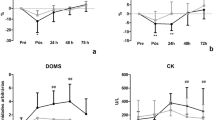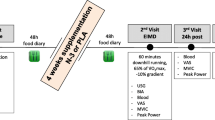Abstract
There is growing evidence that reactive oxygen species (ROS) are involved in the muscular damage and soreness that is observed following strenuous or unaccustomed exercise. This study investigated the relationship between delayed onset muscle soreness (DOMS), muscle function and ROS following downhill running using electron spin resonance (ESR) spectroscopy and plasma malonaldehyde (MDA) concentrations. Eight physically active male subjects participated in two trials consisting of 30 min of running at ~65% V̇O2max on the flat (FLA) or a 15% downhill (DWN) gradient. Venous blood samples were drawn before, immediately after, and then 24, 48 and 72 h post exercise, and at the same time DOMS and muscle function were assessed. Blood was analysed for markers of ROS, total and differential white blood cell count, and creatine kinase. Muscle function was measured on an isokinetic dynamometer, whilst DOMS was assessed using a visual analogue scale. An increase in ROS, detected via ESR spectroscopy and MDA, was observed following DWN (P<0.05) but not following FLA. Increased DOMS and loss of muscle function were observed following DWN (P<0.05) but not following FLA (P>0.05). DWN resulted in a transient leukocytosis (P<0.05) occurring immediately post-exercise but returning to pre-exercise levels by 24 h. Although DWN resulted in an increase in ROS production, the increase occurred after the peak decline in muscle function and DOMS, suggesting that there may be a disassociation in the temporal relationship between ROS, loss of muscle function and DOMS.





Similar content being viewed by others
References
Armstrong RB (1990) Initial events in exercise induced muscular injury. Med Sci Sports Exerc 22:429–435
Ashton T, Rowlands C, Jones E, Young I, Jackson S, Davies B, Peters J (1998) Electron spin resonance spectroscopic detection of oxygen-centered radicals in human serum following exhaustive exercise. Eur J Appl Physiol 77:498–502
Ashton T, Young I, Peters J, Jones E, Jackson S, Davies B, Rowlands C (1999) Electron spin resonance spectroscopy, exercise, and oxidative stress: an ascorbic acid intervention study. J Appl Physiol 87:2032–2036
Bailey D, Davies B, Davison G, Young I (2000) Free radical damage at high altitude; isolating the source and implications for the pathophysiology of acute mountain sickness. Int Soc Mountain Med Newsl 10:3–13
Bailey D, Davies B, Young I, Jackson M, Davison G, Isaacson R, Richardson R (2003) EPR spectroscopic detection of free radical outflow from an isolated muscle bed in exercising humans. J Appl Physiol 94:1714–1718
Borg G (1982) Psychophysical bases of perceived exertion. Med Sci Sports Exerc 14:377–381
Brickson S, Hollander J, Corr D, Ji L, Best T (2001) Oxidant production and immune response after stretch injury in skeletal muscle. Med Sci Sports Exerc 33:2010–2015
Cheeseman, K, Slater T (1993) An introduction to free radical biochemistry. Br Med Bull 49:481–493
Cleak M, Eston R (1992) Delayed onset muscle soreness: mechanisms and management. J Sports Sci 10:325–341
Davies K, Quintanilha A, Brooks G, Packer L (1982) Free radicals and tissue damage produced by exercise. Biochem Biophys Res Commun 31:1198–2005
Dill D, Costill D (1974) Calculation of percentage changes in volume of blood, plasma and red cells in dehydration. J Appl Physiol 6:92–96
Dop Bar P, Reijneveld J, Wokke J, Jacobs S, Bootsma A (1997) Muscle damage induced by exercise: nature, prevention and repair. In: Salmons S (ed) Muscle damage. Oxford University Press, Oxford, pp 1–27
Esterbaur H, Lang J, Zadravec S, Slater S (1984) Detection of malonaldehyde by high-performance liquid chromatography. Methods Enzymol 105:319–328
Eston R, Mickleborough J, Baltzopoulos V (1995) Eccentric activation and muscle damage: biomechanical and physiological considerations during downhill running. Br J Sports Med 29:89–94
Fantone J (1985) Polymorphonuclear leukocyte-mediated cell and tissue injury: oxygen metabolites and their relation to human disease. Human Pathol 16:973–978
Fernandes G (1992) Chronobiology of immune function: cellular and humoral aspects. In: Tuuitou and Haus (eds) Biological rhythms in clinical and laboratory medicine. Springer-Verlag, Berlin Heidelberg New York, pp 493–503
Field A (1999) SPSS for Windows, Sage, London, p 334
Groussard C, Rannou-Bekono F, Machefer G, Chevanne M, Vincent S, Sergent O, Cillard J, Gratas-Delamarche A (2003) Changes in blood lipid peroxidation markers and antioxidants after a single sprint anaerobic exercise. Eur J Appl Physiol 89:14–20
Hellsten Y, Frandsen U, Orthenblad N, Sjodin B, Richter E (1997) Xanthine oxidase in human skeletal muscle following eccentric exercise. J Physiol (Lond) 498:239–248
Jackson M (1999) An overview of methods for assessment of free radical activity in biology. P Nutr Soc 58:1001–1006
Jackson M, Edwards R, Symons M (1985) Electron spin resonance studies of intact mammalian skeletal muscle. Biochim Biophys Acta 847:184–190
Johnson K, Sutcliffe L, Edwards R, Jackson M (1988) Calcium ionophore enhances the electron spin resonance signal from isolated skeletal muscle. Biochim Biophys Acta 964:285–288
Kanter M (1998) Free radicals, exercise and antioxidant supplementation. P Nutr Soc 57:9–13
Lovlin R, Cottle P, Kavanagh M, Belcastro N (1987) Are indices of free radical damage related to exercise intensity. Eur J Appl Physiol 56:313–316
Lowe D, Warren G, Ingalls C, Boorstein D, Armstrong R (1995) Muscle function and protein metabolism after initiation of eccentric contraction-induced injury. J Appl Physiol 79:1260–1270
Maughan R, Donnelly A, Gleeson M, Whiting P, Walker K, Clough P (1989) Delayed-onset muscle damage and lipid peroxidation in man after a downhill run. Muscle Nerve 12:332–336
McArdle A, Van Der Meulen J, Catapano M, Symons M, Faulkner J, Jackson M (1999) Free radical activity following contraction-induced injury to the extensor digitorum longus muscles of rats. Free Radic Biol Med 26:1085–1091
McBride J, Kraemer W (1999) Free radicals, exercise and antioxidants. J Strength Cond Res 13:175–183
Newham D (1988) The consequences of eccentric contractions and their relationship to delayed onset muscle pain. Eur J Appl Physiol 57:353–359
Pattwell D, Ashton T, McArdle A, Griffiths R, Jackson M (2003) Ischaemia and reperfusion of skeletal muscle leads to appearance of a stable lipid free radical in the circulation. Am J Physiol 284:H2400–H2404
Pyne D (1994) Exercise-induced muscle damage and inflammation: a review. Aust J Sci Med Sport 26:49–58
Radak Z, Pucsok J, Mecseki S, Csont T, Ferdinandy P (1999) Muscle soreness-induced reduction in force generation is accompanied by increased nitric oxide content and DNA damage in human skeletal muscle. Free Radic Biol Med 26:1059–1063
Saxton J, Donnelly A, Roper H (1994) Indices of free-radical-mediated damage following maximum voluntary eccentric and concentric muscular work. Eur J Appl Physiol 68:189–193
Sorichter S, Puschendorf B, Mair J (1999) Skeletal muscle injury induced by eccentric muscle action: muscle proteins as markers of muscle fiber injury. Exerc Immunol Rev 5:5–21
Thompson D, Williams C, McGregor S, Nicholas C, McArdle F, Jackson M, Powell J (2001) Prolonged vitamin C supplementation and recovery from demanding exercise. Int J Sport Nutr Exerc Metab 11:466–481
Warren J, Jenkins R, Packer L, Witt E, Armstrong R (1992) Elevated muscle vitamin E does not attenuate eccentric exercise-induced muscle injury. J Appl Physiol 72:2168–2175
Acknowledgements
The authors would like to thank Dr Frank McArdle and Dr Anne McArdle from the Department of Medicine, University of Liverpool, for assistance with the MDA analysis and helpful scientific discussions, and Mr Paul Buckley from the Research Institute for Sport and Exercise Sciences, Liverpool John Moores University for his help with the data collection. Finally we would like to thank all subjects, their efforts are very much appreciated.
Author information
Authors and Affiliations
Corresponding author
Rights and permissions
About this article
Cite this article
Close, G.L., Ashton, T., Cable, T. et al. Eccentric exercise, isokinetic muscle torque and delayed onset muscle soreness: the role of reactive oxygen species. Eur J Appl Physiol 91, 615–621 (2004). https://doi.org/10.1007/s00421-003-1012-2
Accepted:
Published:
Issue Date:
DOI: https://doi.org/10.1007/s00421-003-1012-2




